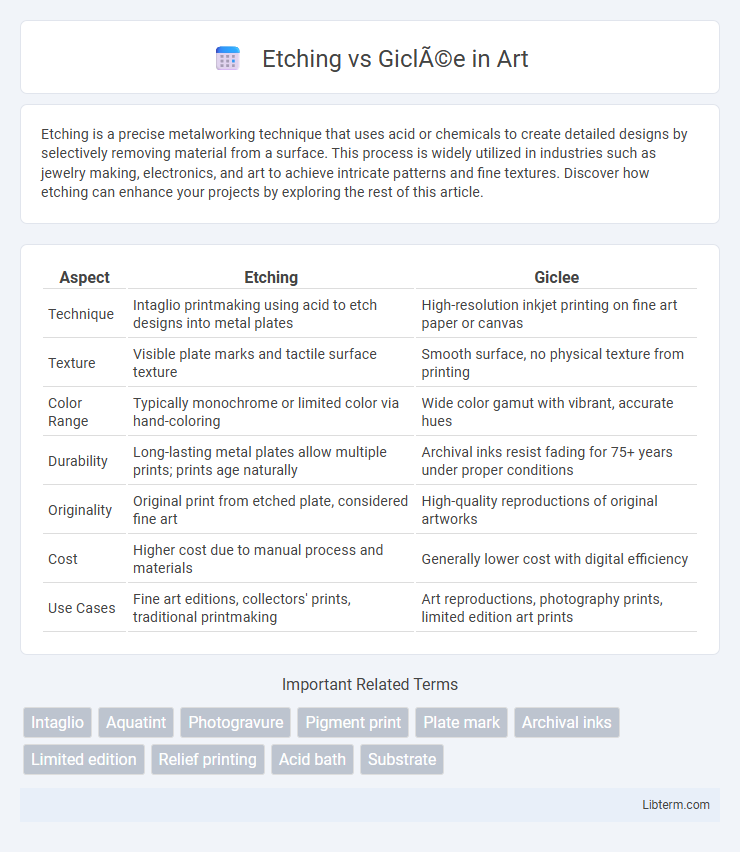Etching is a precise metalworking technique that uses acid or chemicals to create detailed designs by selectively removing material from a surface. This process is widely utilized in industries such as jewelry making, electronics, and art to achieve intricate patterns and fine textures. Discover how etching can enhance your projects by exploring the rest of this article.
Table of Comparison
| Aspect | Etching | Giclee |
|---|---|---|
| Technique | Intaglio printmaking using acid to etch designs into metal plates | High-resolution inkjet printing on fine art paper or canvas |
| Texture | Visible plate marks and tactile surface texture | Smooth surface, no physical texture from printing |
| Color Range | Typically monochrome or limited color via hand-coloring | Wide color gamut with vibrant, accurate hues |
| Durability | Long-lasting metal plates allow multiple prints; prints age naturally | Archival inks resist fading for 75+ years under proper conditions |
| Originality | Original print from etched plate, considered fine art | High-quality reproductions of original artworks |
| Cost | Higher cost due to manual process and materials | Generally lower cost with digital efficiency |
| Use Cases | Fine art editions, collectors' prints, traditional printmaking | Art reproductions, photography prints, limited edition art prints |
Introduction to Etching and Giclée
Etching is a traditional intaglio printmaking technique that involves using acid to carve designs into a metal plate, producing fine, intricate lines and rich textures. Giclee is a modern digital printing process utilizing high-resolution inkjet printers to produce vibrant, museum-quality reproductions of artwork on various substrates. Both methods offer distinct aesthetic qualities, with etching emphasizing handcrafted detail and giclee providing precise color accuracy and versatility.
What is Etching?
Etching is a traditional intaglio printmaking technique where a metal plate is coated with a waxy ground, then scratched with a needle to create a design that is etched by acid. This process allows for fine lines and detailed textures, making it ideal for producing intricate artwork with rich tonal variations. Etched prints often exhibit a distinctive depth and character that differentiate them from Giclee prints, which are produced using high-resolution inkjet printing technology.
What is Giclée Printing?
Giclee printing is a high-quality inkjet printing process that uses archival-grade inks and papers to produce detailed, vibrant art reproductions with exceptional color accuracy and longevity. Unlike traditional etching, which involves engraving a design onto a metal plate and printing through press, giclee enables fine art prints directly from digital files, preserving the original artwork's depth and texture. This technology is preferred by artists and galleries for producing museum-quality prints that resist fading for decades.
Historical Background of Etching
Etching, a printmaking technique originating in the early 16th century, involves using acid to create intricate designs on metal plates, a method refined by artists like Albrecht Durer and Rembrandt. This traditional process highlights the historical significance of craftsmanship and fine art reproduction before the advent of digital printing. In contrast, Giclee, developed in the late 20th century, uses inkjet technology for high-quality digital prints, emphasizing modern precision over the tactile depth found in etching.
Modern Applications of Giclée
Giclee printing offers superior color accuracy and fine detail resolution, making it ideal for reproducing modern digital art and photographic works with vibrant hues and subtle gradients. This technique utilizes high-quality inkjet printers and archival inks, ensuring longevity and fade resistance in contemporary art applications such as gallery exhibitions and limited edition prints. In contrast to traditional etching, giclee supports a wider color gamut and faster production times, catering to the demand for customizable and reproducible modern artwork.
Artistic Process: Etching vs Giclée
Etching involves a traditional intaglio printmaking technique where artists carve designs into a metal plate coated with acid-resistant ground, then use acid to etch the incised lines before inking and pressing onto paper. Giclee printing employs advanced inkjet technology to produce high-resolution, archival-quality reproductions of original artwork using pigment-based inks on various substrates. The etching process emphasizes manual craftsmanship and unique textural effects, while giclee focuses on precise color accuracy and consistency across multiple prints.
Material Differences and Longevity
Etching prints use metal plates and acid to create detailed images on paper, resulting in a textured surface that enhances visual depth and durability. Giclee prints rely on high-quality inkjet technology and archival paper or canvas, offering vibrant colors and fade resistance. Etching generally boasts superior longevity due to its physical engraving process, while giclee's lifespan depends heavily on ink and substrate quality.
Print Quality and Detail Comparison
Etching prints exhibit exceptional detail due to the intricate process of engraving on metal plates, capturing fine lines and textures with high precision that results in a rich, tactile quality. Giclee prints achieve superior color accuracy and smooth gradient transitions using high-resolution inkjet technology, producing vibrant, photo-realistic images with sharp detail and longevity through archival pigment inks. While etching emphasizes depth and texture in line work, giclee excels in reproducing complex color palettes and subtle tonal variations, making print quality and detail distinct yet complementary between the two methods.
Cost and Accessibility
Etching involves complex, time-intensive techniques requiring specialized tools and skilled artisans, resulting in higher production costs and limited accessibility. Giclee printing utilizes high-resolution inkjet technology, offering affordable, quick reproduction with broad accessibility for artists and collectors. Cost efficiency and ease of access make Giclee a popular choice for contemporary art prints compared to the traditional and pricier etching process.
Choosing Between Etching and Giclée
Choosing between etching and giclee depends on desired artistic texture and reproduction detail; etching offers rich, tactile qualities with traditional intaglio techniques, ideal for collectors seeking original prints. Giclee provides high-resolution digital prints with vibrant colors on archival materials, suitable for artists requiring rapid, cost-effective reproductions. Consider the longevity, surface finish, and edition size when selecting the appropriate printmaking method for artwork presentation or sale.
Etching Infographic

 libterm.com
libterm.com